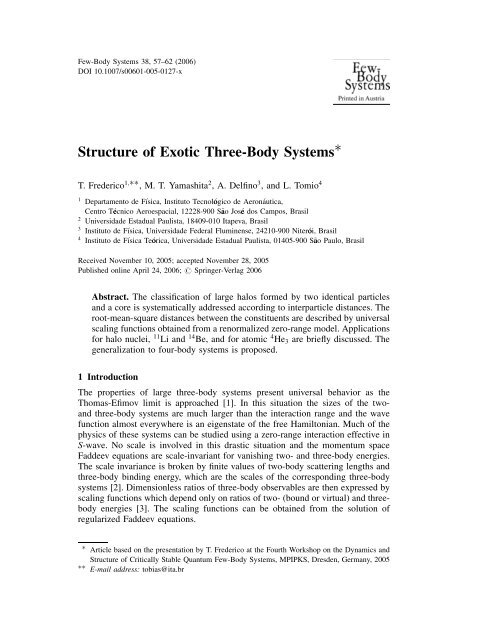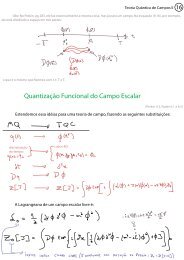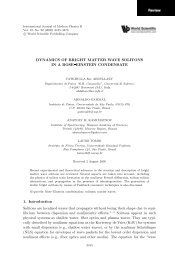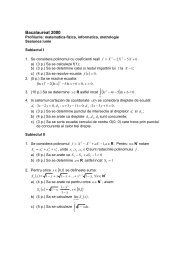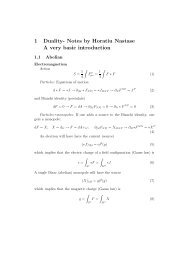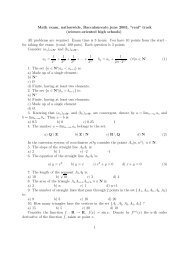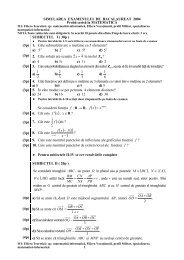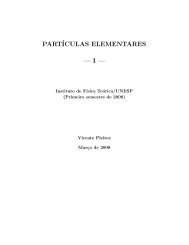Download PDF - Springer
Download PDF - Springer
Download PDF - Springer
Create successful ePaper yourself
Turn your PDF publications into a flip-book with our unique Google optimized e-Paper software.
Few-Body Systems 38, 57–62 (2006)<br />
DOI 10.1007/s00601-005-0127-x<br />
Structure of Exotic Three-Body Systems <br />
T. Frederico 1; , M. T. Yamashita 2 , A. Delfino 3 , and L. Tomio 4<br />
1 Departamento de Física, Instituto Tecnologico de Aeronáutica,<br />
Centro Tecnico Aeroespacial, 12228-900 S~ao Jose dos Campos, Brasil<br />
2 Universidade Estadual Paulista, 18409-010 Itapeva, Brasil<br />
3 Instituto de Física, Universidade Federal Fluminense, 24210-900 Niteroi, Brasil<br />
4 Instituto de Física Teorica, Universidade Estadual Paulista, 01405-900 S~ao Paulo, Brasil<br />
Received November 10, 2005; accepted November 28, 2005<br />
Published online April 24, 2006; # <strong>Springer</strong>-Verlag 2006<br />
Abstract. The classification of large halos formed by two identical particles<br />
and a core is systematically addressed according to interparticle distances. The<br />
root-mean-square distances between the constituents are described by universal<br />
scaling functions obtained from a renormalized zero-range model. Applications<br />
for halo nuclei, 11 Li and 14 Be, and for atomic 4 He 3 are briefly discussed. The<br />
generalization to four-body systems is proposed.<br />
1 Introduction<br />
The properties of large three-body systems present universal behavior as the<br />
Thomas-Efimov limit is approached [1]. In this situation the sizes of the twoand<br />
three-body systems are much larger than the interaction range and the wave<br />
function almost everywhere is an eigenstate of the free Hamiltonian. Much of the<br />
physics of these systems can be studied using a zero-range interaction effective in<br />
S-wave. No scale is involved in this drastic situation and the momentum space<br />
Faddeev equations are scale-invariant for vanishing two- and three-body energies.<br />
The scale invariance is broken by finite values of two-body scattering lengths and<br />
three-body binding energy, which are the scales of the corresponding three-body<br />
systems [2]. Dimensionless ratios of three-body observables are then expressed by<br />
scaling functions which depend only on ratios of two- (bound or virtual) and threebody<br />
energies [3]. The scaling functions can be obtained from the solution of<br />
regularized Faddeev equations.<br />
Article based on the presentation by T. Frederico at the Fourth Workshop on the Dynamics and<br />
Structure of Critically Stable Quantum Few-Body Systems, MPIPKS, Dresden, Germany, 2005<br />
E-mail address: tobias@ita.br
58 T. Frederico et al.<br />
The sizes of halo three-body systems (where two particles are identical) are<br />
functions of few physical scales. A classification scheme for these systems [4–6]<br />
ordered by their sizes is reviewed. For a given three-body binding energy the most<br />
compact system is the Borromean (single pairs are unbound) while the all-bound<br />
(all single pairs form bound states) is the largest one. The neutron-neutron mean<br />
square radius in examples of Borromean halo nuclei which are known experimentally<br />
[7] are briefly discussed. The extension of these ideas to four-body systems is<br />
proposed.<br />
2 Scale Invariance in Three-Boson Systems<br />
The collapse of a three-boson system when the two-body interaction range goes to<br />
zero (Thomas effect, see ref. [1]) demands one new physical scale to stabilize the<br />
three-boson binding energy (E 3 ). The regulated trimer bound-state integral equation<br />
in units of h ¼ m ¼ 1(m is the boson mass) is written as<br />
ð<br />
3 1 ð 1<br />
f ðqÞ ¼2 E 3<br />
4 q2 k 2 dk f ðkÞ dz G 0 ðE 3 Þ G 0 ð 2 ð3Þ Þ ; ð1Þ<br />
0<br />
1<br />
where G0 1ðEÞ<br />
¼E q2 k 2 qkz, and the renormalized two-boson scattering<br />
amplitude is 1 ðxÞ ¼2 2 ½a 1 pffiffiffiffiffiffi<br />
x Š. Without regularization, Eq. (1) is the<br />
Skorniakov and Ter-Martirosyan (SKTM) equation derived long ago [8] which is<br />
scale-invariant when the scattering length jaj tends to infinity and E 3 ¼ 0. The<br />
second term in Eq. (1) brings the physical scale, ð3Þ , to the three-boson system<br />
[2] avoiding the Thomas collapse. The equivalence of Thomas and Efimov effects<br />
is seen in units of ð3Þ ¼ 1, which means jaj ð3Þ !1either for jaj !1(Efimov<br />
limit) or for ð3Þ !1(Thomas limit).<br />
The sensitivity of three-boson S-wave observables to the short-range part of<br />
the interaction in weakly bound systems is parameterized through the value of the<br />
trimer binding energy which corresponds to the scale ð3Þ . Three-boson S-wave<br />
observables are strongly correlated to the trimer energy in a general universal<br />
form [3, 9],<br />
p<br />
O 3 ðE; E 3 ; aÞ ¼jE 3 j F 3 ðE=E 3 ; a<br />
ffiffiffiffiffiffiffiffi<br />
jE 3 j Þ ; ð2Þ<br />
where O 3 can represent a scattering amplitude at an energy E or an excited trimer<br />
energy (the dependence on E does not appear in this case). The exponent gives<br />
the correct dimension to O 3 . Eq. (1) is renormalization-group (RG) invariant with<br />
its kernel being a solution of a Callan-Symanzik differential equation as function of<br />
a sliding ð3Þ . In that way E 3 and three-body observables are independent of the<br />
subtraction point (see ref. [9] for a discussion of the RG invariance in three-body<br />
systems).<br />
3 Classification of Three-Body Halos and Universal Scalings<br />
The sizes of halo three-body systems (with two identical particles () and a distinct<br />
one ()) are functions of few physical scales. A classification scheme for these<br />
systems as Borromean (single pairs are unbound), Tango (only the pair forms a
Structure of Exotic Three-Body Systems 59<br />
bound state), Samba (only the pair is bound) and all-bound (all single pairs<br />
form bound states), ordered by their sizes is discussed below.<br />
The typical lengths of the three-body halo systems are given by scaling functions<br />
for the mean-square separation distances written according to Eq. (2). The<br />
scaling functions for these radii are<br />
qffiffiffiffiffiffiffiffiffiffiffiffiffiffiffiffiffi<br />
qffiffiffiffiffiffiffiffiffiffiffiffiffiffiffi<br />
qffiffiffiffiffiffiffiffiffiffiffiffiffiffiffi<br />
<br />
hr 2 ijE 3j<br />
qffiffiffiffiffiffiffiffiffiffiffiffiffiffiffi<br />
hr 2ijE 3j<br />
¼R n<br />
¼R cm<br />
<br />
E =E 3 ; E =E 3 ; A ; ð3Þ<br />
qffiffiffiffiffiffiffiffiffiffiffiffiffiffiffi<br />
qffiffiffiffiffiffiffiffiffiffiffiffiffiffiffi<br />
<br />
E =E 3 ; E =E 3 ; A ; ð4Þ<br />
where hr 2 i and hr2 i are, respectively, the mean-square relative and centre-of-mass<br />
distances. The mass ratio is A ¼ m =m and is or . The þ or signs represent<br />
bound or virtual two-body subsystems, respectively. E and E are the and<br />
two-body energies.<br />
For a given energy E 3 and identical particles, the effective interaction in Eq. (1)<br />
has a weaker strength for a < 0 (virtual two-body system) than for a > 0 (bound<br />
two-body system). Therefore, for a Borromean trimer Eq. (1) should have a larger<br />
value of 3 than the corresponding one for an all-bound system, in order to keep<br />
the binding fixed with a weaker interaction. The spectator function, f ðqÞ, extends to<br />
a large momentum for a Borromean system. The trimer wave function for the zero<br />
total angular momentum is<br />
ðq; pÞ ¼ f ðjqjÞ þ f ðj p þ 1 2 qjÞ þ f ðj p 1<br />
2 qjÞ ; ð5Þ<br />
3<br />
E 3 4 q2 p 2<br />
which implies in a more compact spatial configuration for a Borromean trimer<br />
in comparison to the all-bound one. The Jacobi relative momenta are p for the<br />
pair and q for the spectator particle. In terms of the scaling functions the radii<br />
come as<br />
pffiffiffiffiffiffiffiffiffiffiffiffiffiffiffi<br />
pffiffiffiffiffiffiffiffiffiffiffiffiffiffiffi<br />
R E =E 3<br />
< R E =E 3 ; ð6Þ<br />
pffiffiffiffiffiffiffiffiffiffiffiffiffiffiffiffiffiffi<br />
and the separation distances obey hr 2 ijE 3jB <<br />
p ffiffiffiffiffiffiffiffiffiffiffiffiffiffiffiffiffiffi<br />
hr 2 ijE 3j , where the labels<br />
A<br />
B and A correspond to Borromean and all-bound systems, pffiffiffiffiffiffiffiffiffiffiffiffiffiffiffi<br />
respectively. For the<br />
same reasons that led to Eq. (6), it is also valid that hr 2ijE 3jB <<br />
p ffiffiffiffiffiffiffiffiffiffiffiffiffiffiffi<br />
hr 2ijE 3jA .<br />
The zero-range model applied to atomic 4 He 3 provides a qualitative understanding<br />
of the radii results of realistic calculations for the ground and excited states<br />
pffiffiffiffiffiffiffiffiffiffi<br />
[10] with an estimation of hr 2 i<br />
p<br />
¼C<br />
ffiffiffiffiffiffiffiffiffiffiffiffiffiffiffiffiffiffiffiffiffiffiffiffiffiffiffiffiffiffiffiffiffiffiffiffiffiffiffiffi<br />
h 2 =½m ðjE 3 E jÞŠ with 0:6 < C < 1<br />
[6]. Also the excited trimer state energy of 4 He 3 , E 3 , has a scaling behavior<br />
written as<br />
qffiffiffiffiffiffiffiffiffiffiffiffiffiffiffiffiffiffiffiffiffiffi<br />
jE p<br />
3<br />
E j ¼<br />
ffiffiffiffiffiffiffiffi pffiffiffiffiffiffiffiffiffiffiffiffiffiffiffi<br />
jE 3 j E E =E 3 ; ð7Þ<br />
which is consistent with the results from realistic calculations (see refs. [3, 9] and<br />
references therein). The threshold for the appearance of an excited Efimov trimer<br />
state from the second energy sheet is jE 3 j¼6:9=a 2 [9, 11] in units of h ¼ m ¼ 1.<br />
The scaling behavior was extended to the complex energy plane and for threeboson<br />
Borromean systems, the excited Efimov state turns into a resonance when<br />
the virtual two-boson virtual state energy is decreased [12].
60 T. Frederico et al.<br />
The generalization of the reasonings leading to Eq. (6) to the system gives<br />
the qualitative classification of the different three-body systems in respect to sizes.<br />
The effective interaction is weaker when a pair has a virtual state than when the<br />
pair is bound, and the three-body system has to shrink to keep the binding energy<br />
unchanged if a pair which is bound turns to be virtual. Therefore it is reasonable to<br />
expect that<br />
qffiffiffiffiffiffiffiffiffiffiffiffiffiffiffi<br />
qffiffiffiffiffiffiffiffiffiffiffiffiffiffiffi<br />
qffiffiffiffiffiffiffiffiffiffiffiffiffiffiffi<br />
qffiffiffiffiffiffiffiffiffiffiffiffiffiffiffi<br />
<br />
R E =E 3 ; E =E 3 ; A<br />
< R E =E 3 ; E =E 3 ; A<br />
qffiffiffiffiffiffiffiffiffiffiffiffiffiffiffi<br />
qffiffiffiffiffiffiffiffiffiffiffiffiffiffiffi<br />
qffiffiffiffiffiffiffiffiffiffiffiffiffiffiffi<br />
qffiffiffiffiffiffiffiffiffiffiffiffiffiffiffi<br />
<br />
< R E =E 3 ; E =E 3 ; A<br />
< R E =E 3 ; E =E 3 ; A ; ð8Þ<br />
which was checked numerically [6]. An analogous relation is qvalid ffiffiffiffiffiffiffiffiffiffiffiffiffiffiffiffiffi for R cm<br />
.<br />
The qffiffiffiffiffiffiffiffiffiffiffiffiffiffiffiffiffiffi<br />
dimensionless products (we are using units of h ¼ m ¼ 1) hr 2 ijE 3j and<br />
hr 2 ijE 3j increase from Borromean, Tango, Samba and to all-bound configurations,<br />
systematizing the classification scheme proposed in ref. [5] for weakly<br />
bound three-body systems.<br />
A three-body model applied to light exotic nuclei [6] compares qualitatively<br />
well with the existent experimental data for the neutron-neutron separation<br />
distance in the neutron-halo of 11 Li and 14 Be [7]. Therefore, the neutrons of<br />
the halo have a large probability to be found outside the interaction range and<br />
the low-energy properties of the halo are, to a large extent, universal as long as<br />
few physical input scales are fixed in the model. An insight into the structure of<br />
halo nuclei can be found even considering the limitations of the model. The<br />
finite size of the core and consequently the antisymmetrization of the total<br />
nuclear wave function are both missing in this simplified description. However,<br />
in examples where the neutrons in the halo tend to be more and more weakly<br />
bound with virtual or bound subsystems near the scattering threshold, the scaling<br />
relations apply for the halo properties, as the above limitations are less<br />
important.<br />
4 Classification of Four-Body Halos and Universal Scalings<br />
The four-boson system has two Faddeev-Yakubovsky (FY) independent amplitudes<br />
and within a zero-range model, they are reduced to spectator amplitudes depending<br />
on two Jacobi momenta. The two spectator FY reduced amplitudes satisfy a<br />
coupled set of integral equations generalizing the SKTM equation for three bosons.<br />
The set of coupled integral equations needs regularization, and one recognizes that<br />
the resolvent of the immersed three-boson subsystem carries the scale ð3Þ . Other<br />
terms are present and require regularization. We introduce a scale ð4Þ such that the<br />
four-body free Green’s function G 0 ðE 4 Þ is substituted by G 0 ðE 4 Þ G 0 ð 2 ð4Þ Þ [13]<br />
in a direct generalization of Eq. (1) as suggested by ref. [2].<br />
The momentum scales in the FY equations for the reduced amplitudes are<br />
only a 1 , ð3Þ , and ð4Þ . In this case, the tetramer binding energy depends on the<br />
momentum scales as<br />
E 4 ¼ 2 ð3Þ E 4ð ð4Þ = ð3Þ ; a ð3Þ Þ:<br />
ð9Þ
Structure of Exotic Three-Body Systems 61<br />
For a ¼1 the trimer binding energy from the solution of Eq. (1) is<br />
E 3 ¼ 0:0093 2 ð3Þ<br />
[9], which simplifies Eq. (9) remaining only the dependence<br />
on the ratio ð4Þ = ð3Þ in E 4 :<br />
E 4 ¼ E 3 E 4 ð ð4Þ = ð3Þ Þ:<br />
ð10Þ<br />
If E 4 is independent on the regularization scale ð4Þ for ð4Þ = ð3Þ >> 1 the four-body<br />
scale is not important. We solved numerically the FY equations up to large values<br />
of ð4Þ = ð3Þ 20 [13].<br />
The tetramer ground-state binding energy was calculated for different values<br />
of the ratio ð4Þ = ð3Þ with a ¼1. The ratio E 4 =E 3 depends strongly on<br />
ð4Þ = ð3Þ . For equal three- and four-body scales, i.e., ð4Þ = ð3Þ ¼ 1, the tetramer<br />
binding energy is E 4 ¼ 5E 3 , agreeing with the angular coefficient of the Tjon<br />
line [14], E 4 ¼ 4:72ðE 3 þ 2:48Þ MeV (E 4 is the 4 He energy and E 3 the triton<br />
one). Also, a recent calculation [15] of the four-boson system with a two-body<br />
zero-range force and a repulsive three-body potential to stabilize the trimer<br />
against collapse, E 4 ,scalesas5E 3 . Our result for ð4Þ ¼ ð3Þ agrees with both.<br />
However, for ð4Þ = ð3Þ ¼ 20 we found that the ratio between the tetramer and<br />
trimer energies is about 78, indicating the independent effect of the fourbody<br />
scale.<br />
The present results suggest that the general scaling of S-wave three-boson<br />
observables with the physical scales, Eq. (2), may be generalized to four-boson<br />
S-wave observables. The effect of the short-range dynamics in an observable<br />
comes through the values of the scattering length, trimer and tetramer binding<br />
energies, associated with ð3Þ and ð4Þ , respectively. In this case, an S-wave<br />
four-boson observable will be strongly correlated to a, E 3 , and E 4 ,<br />
<br />
pffiffiffiffiffiffiffiffi<br />
O 4 ðE; E 4 ; E 3 ; aÞ ¼jE 4 j F 4 E=E 4 ; E 3 =E 4 ; a jE 4 j ; ð11Þ<br />
where O 4 represents either a scattering amplitude at energy E, or an excited tetramer<br />
energy or some observable related to the tetramer (the dependence on E<br />
does not appear in these cases). The exponent gives the correct dimension to O 4 .<br />
For sizes one could think that the relation<br />
pffiffiffiffiffiffiffiffiffiffiffiffi<br />
pffiffiffiffiffiffiffiffiffiffiffiffiffiffiffi<br />
pffiffiffiffiffiffiffiffiffiffiffiffi<br />
pffiffiffiffiffiffiffiffiffiffiffiffiffiffiffi<br />
R E 3 =E 4 ; E =E 4<br />
< R E 3 =E 4 ; E =E 4 ; ð12Þ<br />
and the analogous one for the distances of the particles to the centre of mass would<br />
be valid. This indicates that it is possible to envisage a generalized classification<br />
scheme based on sizes including weakly-bound four-body systems.<br />
5 Outlook and Conclusions<br />
The classification scheme of large halos formed by two identical particles and a<br />
core is reviewed and addressed systematically according to their sizes. The rootmean-square<br />
distances between the constituents are described by universal scaling<br />
functions. For a given three-body system and total energy, the Borromean configuration<br />
is the most compact one. Applications to halo nuclei, 11 Li and 14 Be, and for<br />
atomic 4 He 3 were briefly discussed.
62 T. Frederico et al.<br />
The generalization of these concepts to four-body systems is proposed. We<br />
have shown that for a zero-range two-body interaction with an infinite scattering<br />
length and a fixed trimer ground-state binding energy, a four-boson momentum<br />
scale is evidenced in the calculation of tetramer binding energies in three dimensions.<br />
The intensity of the effective interaction that composes the kernel of the<br />
reduced FY spectator equations depends on the dimer energy and trimer, therefore<br />
it is reasonable that a tetramer becomes more compact for a given four-body<br />
energy if the two- and three-body binding are decreased. This effect indicates that<br />
it may be possible to generalize the classification scheme of weakly-bound threebody<br />
systems to four-body systems.<br />
Acknowledgement. We thank the Brazilian funding agencies FAPESP and CNPq.<br />
References<br />
1. Jensen, A. S., Riisager, K., Fedorov, D. V., Garrido, E.: Rev. Mod. Phys. 76, 215 (2004)<br />
2. Adhikari, S. K., Frederico, T., Goldman, I. D.: Phys. Rev. Lett. 74, 487 (1995)<br />
3. Frederico, T., Tomio, L., Delfino, A., Amorim, A. E. A.: Phys. Rev. A60, R9 (1999)<br />
4. Robichaux, F.: Phys. Rev. A60, 1706 (1999)<br />
5. Jensen, A. S., Riisager, K., Fedorov, D. V., Garrido, E.: Europhys. Lett. 61, 320 (2003)<br />
6. Yamashita, M. T., Tomio, L., Frederico, T.: Nucl. Phys. A735, 40 (2004); Yamashita, M. T.,<br />
Marques de Carvalho, R. S., Tomio, L., Frederico, T.: Phys. Rev. A68, 012506 (2003)<br />
7. Marques, F. M., et al.: Phys. Lett. B476, 219 (2000); Phys. Rev. C64, 061301 (2001)<br />
8. Skorniakov, G. V., Ter-Martirosyan, K. A.: Sov. Phys. JETP 4, 648 (1957)<br />
9. Yamashita, M. T., Frederico, T., Delfino, A., Tomio, L.: Phys. Rev. A66, 052702 (2002)<br />
10. Barletta, P., Kievsky, A.: Phys. Rev. A64, 042514 (2001)<br />
11. Braaten, E., Hammer, H.-W., Kusunoki, M.: Phys. Rev. A67, 022505 (2003)<br />
12. Bringas, F., Yamashita, M. T., Frederico, T.: Phys. Rev. A69, 040702(R) (2004)<br />
13. Yamashita, M. T., Tomio, L., Delfino, A., Frederico, T.: The four-boson scale near a Feshbach<br />
resonance, cond-mat=0602549<br />
14. Tjon, J. A.: Phys. Lett. 56B, 217 (1975); Perne, R. E., Kroeger, H.: Phys. Rev. C20, 340 (1979);<br />
Tjon, J. A.: Nucl. Phys. A353, 470 (1981)<br />
15. Platter, L., Hammer, H.-W., Meissner, U.-G.: Phys. Rev. A70, 052101 (2004)


